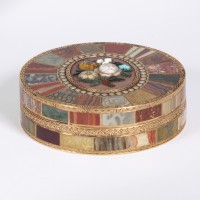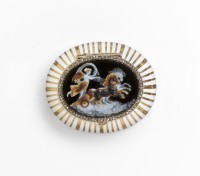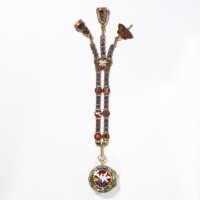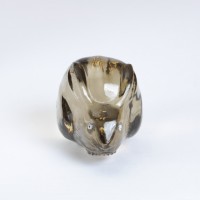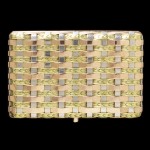 The The Victoria and Albert Museum (V&A) is the proud new owner of nine exceptional works by Carl Fabergé donated by the son of the late Kenneth Snowman, one of the world’s most prominent Fabergé experts. Two rare works by 18th century goldsmith Johann Christian Neuber were also part of the donation. Nicholas Snowman donated the pieces in the Kenneth and Sallie Snowman Collection under the Cultural Gifts Scheme, a program that allows the donation of significant cultural heritage objects in exchange for tax savings in the amount of 30% of their market value, in this case a discount of £615,000 ($772,000).
The The Victoria and Albert Museum (V&A) is the proud new owner of nine exceptional works by Carl Fabergé donated by the son of the late Kenneth Snowman, one of the world’s most prominent Fabergé experts. Two rare works by 18th century goldsmith Johann Christian Neuber were also part of the donation. Nicholas Snowman donated the pieces in the Kenneth and Sallie Snowman Collection under the Cultural Gifts Scheme, a program that allows the donation of significant cultural heritage objects in exchange for tax savings in the amount of 30% of their market value, in this case a discount of £615,000 ($772,000).
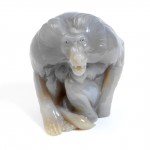 The Fabergé pieces in the donation include four animals masterfully carved out of chalcedony and agate for Queen Alexandra, wife of King Edward VII and Tsar Nicholas II’s aunt, herself an accomplished wood carver. Alexandra’s Fabergé animals are a hissing baboon, a sturgeon, a kangaroo and a chinchilla. Other animals in the collection include a seal carved out of obsidian with such dazzling attention to detail that the skin texture is perfectly matched to the stone, and a quartz hare inspired by Japanese netsuke. One of the objects, a rock crystal letter opener, has a moving sentimental connection to
The Fabergé pieces in the donation include four animals masterfully carved out of chalcedony and agate for Queen Alexandra, wife of King Edward VII and Tsar Nicholas II’s aunt, herself an accomplished wood carver. Alexandra’s Fabergé animals are a hissing baboon, a sturgeon, a kangaroo and a chinchilla. Other animals in the collection include a seal carved out of obsidian with such dazzling attention to detail that the skin texture is perfectly matched to the stone, and a quartz hare inspired by Japanese netsuke. One of the objects, a rock crystal letter opener, has a moving sentimental connection to 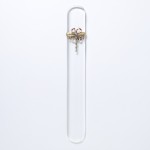 the last of the Romanovs. It was a present given by Tsarina Alexandra to her onetime English governess, Miss Jackson, for Christmas in 1900. Miss Jackson had become a surrogate mother for Alexandra after her own mother died from diphtheria, contracted during her tireless nursing of her entire family when they were stricken by the disease. Alexandra was just six years old when her mother died, so Miss Jackson provided much-needed support to the bereft child.
the last of the Romanovs. It was a present given by Tsarina Alexandra to her onetime English governess, Miss Jackson, for Christmas in 1900. Miss Jackson had become a surrogate mother for Alexandra after her own mother died from diphtheria, contracted during her tireless nursing of her entire family when they were stricken by the disease. Alexandra was just six years old when her mother died, so Miss Jackson provided much-needed support to the bereft child.
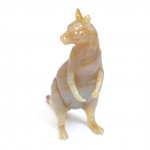 Kenneth Snowman is a Fabergé legend. The son of jeweller Emanuel Snowman and Harriet Wartski, daughter of Morris Wartski, founder of the Wartski company which, thanks to Emanuel’s buying trips to the Soviet Union in the 20s and 30s when Fabergé had dropped out of cultural consciousness, became the leading dealers and experts in Fabergé’s exquisite Imperial Eggs and the many jeweled and enamelled treasures he made for the aristocracy of pre-Revolutionary Russia. Born in 1919, as a child Kenneth played with
Kenneth Snowman is a Fabergé legend. The son of jeweller Emanuel Snowman and Harriet Wartski, daughter of Morris Wartski, founder of the Wartski company which, thanks to Emanuel’s buying trips to the Soviet Union in the 20s and 30s when Fabergé had dropped out of cultural consciousness, became the leading dealers and experts in Fabergé’s exquisite Imperial Eggs and the many jeweled and enamelled treasures he made for the aristocracy of pre-Revolutionary Russia. Born in 1919, as a child Kenneth played with 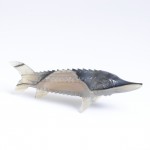 some of the nine Imperial Eggs his father brought home from the Soviet Union. Little wonder, then, that as an adult he become a published Fabergé scholar, curator and world-renowned expert. When his father-in-law died, he became chairman of Wartski, which you might recall played an integral role in the stranger-than-fiction saga of the lost Imperial Egg found by a scrap metal dealer in the US midwest.
some of the nine Imperial Eggs his father brought home from the Soviet Union. Little wonder, then, that as an adult he become a published Fabergé scholar, curator and world-renowned expert. When his father-in-law died, he became chairman of Wartski, which you might recall played an integral role in the stranger-than-fiction saga of the lost Imperial Egg found by a scrap metal dealer in the US midwest.
Nicholas Snowman’s choice of the V&A was a tribute to his father’s deep bonds with the institution.
The donor, Nicholas Snowman, son of Kenneth, said: “In 1977 my father curated a major Fabergé exhibition at the Victoria and Albert Museum to honour the Queen’s Silver Jubilee. He was devoted to the V&A.”
He said following the latest donation the V&A now “possesses the most significant public collection of Fabergé in Britain and its important collection of gold boxes has been enriched enormously.”
Tristram Hunt, director of the Victoria & Albert Museum, said: “Nicholas Snowman’s Cultural Gift is the most important donation of Fabergé ever made to a British public collection and will greatly enrich the V&A’s jewellery holdings. It is an act of great generosity and cultural philanthropy.”
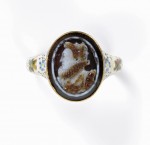 Underscoring the generosity of the act is a 13th object Nicholas Snowman donated to the V&A, only he didn’t do it directly. He deliberately donated a 16th century cameo portrait of Elizabeth I later mounted on a ring to the Art Fund who then (by arrangement) donated it to the V&A. He did this in recognition of the Art Fund’s hugely successful campaign to acquire the Armada Portrait for the Royal Museums Greenwich.
Underscoring the generosity of the act is a 13th object Nicholas Snowman donated to the V&A, only he didn’t do it directly. He deliberately donated a 16th century cameo portrait of Elizabeth I later mounted on a ring to the Art Fund who then (by arrangement) donated it to the V&A. He did this in recognition of the Art Fund’s hugely successful campaign to acquire the Armada Portrait for the Royal Museums Greenwich.
